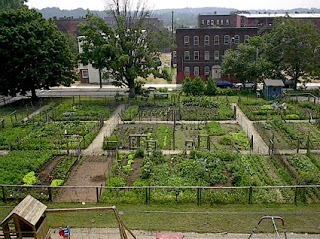How to grow food where we need it
Madeline Ostrander
Yes Magazine
The first time I went to Richmond, Calif., nine years ago, my friend, who ran a punk music recording studio out of a converted warehouse, told us not to park our car on the street. The day before, vandals had walked the block and smashed several car windows.
At least a few things have started to change in Richmond since then: A berry garden sits beside a bike trail in the Iron Triangle, a neighborhood at the center of the city bordered on three sides by old rail lines. Once a month, Latino and African American families–often people who live just a few blocks from each other but rarely had a chance to meet in the past–gather at the garden and have a barbecue. Tomatoes, chard, and corn grow in raised beds across the street. Muslim families from the local mosque just a few blocks away pluck fresh mint from the garden for making traditional Arabic tea. The garden is the work of Urban Tilth, one of the dozen or so groups at the center of Richmond’s urban garden movement. It was built by community members, often young people, and is tended in part by students and teachers from the elementary school next door. And it has become a community gathering space.
Richmond boomed in the mid-20th century and now is like hundreds of other places around the country where industry walked away. The city is isolated from much of the cultural and economic life of the rest of the East Bay region. Young people can’t find jobs, and they move away, or their restlessness is channeled into all the wrong activities—vandalism, gangs, crime.
RELATED ARTICLES:
Two Non-GMO Farming Innovations That Show Great Promise
Mimicking Nature to Feed the Masses


Be the first to comment on "From Vacant City Lots to Food on the Table"